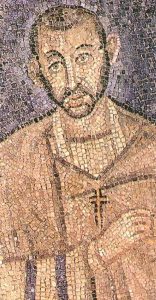Ambrosians
 AMBROSIANS, the name given to several religious brotherhoods which at various times since the 14th century have sprung up in and around Milan; they have about as much connection with St Ambrose as the “Jeromites” who were found chiefly in upper Italy and Spain have with their patron saint. Only the oldest of them, the Pratres S. Ambrosii ad Nemus, had anything more than a very local significance. This order is known from a bull of Gregory XI. addressed to the monks of the church of St Ambrose outside Milan. These monks, it would appear, though under the authority of a prior, had no rule. In response to the request of the archbishop, the pope had commanded them to follow the rule of Augustine and to be known by the above name. They were further to recite the Ambrosian office. Subsequently the order had a number of independent establishments in Italy which were united into one congregation by Eugenius IV., their headquarters being at Milan. Their discipline afterwards became so slack that an appeal was made to Cardinal Borromeo asking him to reform their houses. By Sixtus V. the order was amalgamated with the congregation of St Barnabas, but Innocent X. dissolved it in 1650.
AMBROSIANS, the name given to several religious brotherhoods which at various times since the 14th century have sprung up in and around Milan; they have about as much connection with St Ambrose as the “Jeromites” who were found chiefly in upper Italy and Spain have with their patron saint. Only the oldest of them, the Pratres S. Ambrosii ad Nemus, had anything more than a very local significance. This order is known from a bull of Gregory XI. addressed to the monks of the church of St Ambrose outside Milan. These monks, it would appear, though under the authority of a prior, had no rule. In response to the request of the archbishop, the pope had commanded them to follow the rule of Augustine and to be known by the above name. They were further to recite the Ambrosian office. Subsequently the order had a number of independent establishments in Italy which were united into one congregation by Eugenius IV., their headquarters being at Milan. Their discipline afterwards became so slack that an appeal was made to Cardinal Borromeo asking him to reform their houses. By Sixtus V. the order was amalgamated with the congregation of St Barnabas, but Innocent X. dissolved it in 1650.
The name Ambrosians is also given to a 16th-century Anabaptist sect, which laid claim to immediate communication with God through the Holy Ghost. Basing their theology upon the words of the Gospel of St John i. 9 — “There was the true light which lighteth every man, coming into the world”—they denied the necessity of any priests or ministers to interpret the Bible. Their leader Ambrose went so far as to hold further that the revelation which was vouchsafed to him was a higher authority than the Scriptures. The doctrine of the Ambrosians, who belonged probably to that section of the Anabaptists known as Pneumatici, may be compared with the “Inner Light” doctrine of the Quakers.
See Herzog-Hauck’s Realencyklopadie, i. 439.
